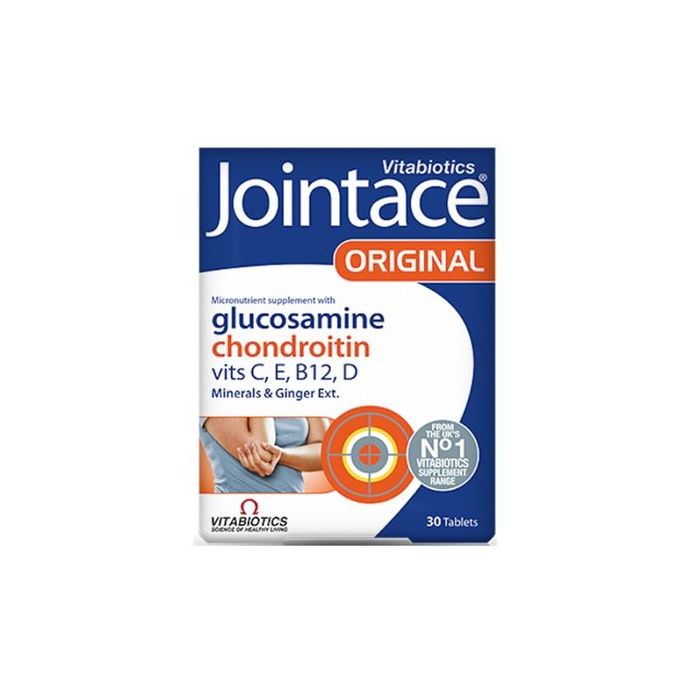
What’s in Jointace Max
Most of the ingredients in Jointace Max are linked to joint health and have been shown to reduce symptoms of various joint-related ailments. Where this supplement falls short is in doses. Despite the product containing two tablets and one capsule, there is surprisingly little in it. Most of the ingredients are not properly dosed, and while they might have some mild benefits, higher doses will undoubtedly have a better impact on joint health.
Glucosamine and chondroitin - These two ingredients are commonly found in supplements for joints. They work in a symbiotic relationship, with chondroitin increasing the potency glucosamine. Both chondroitin and glucosamine are natural compounds that exist in cartilage. In Europe, and to a lesser extent the USA, both are commonly prescribed for osteoarthritis.
For glucosamine, a dose of between 500mg and 3g per day is recommended. Joinatace Max contains 1g, making it passable if a little on the low side of the recommended dosage. As for chondroitin, a minimum dose of 800mg has been shown to be effective, making the 250mg dose in Jointace Max far too low.
Collagen - Collagen type II is found naturally in joints. As you age the amount of naturally occurring collagen decreases leaving joints more susceptible to joint issues like osteoarthritis. Taken orally, collagen type II is an anti-inflammatory that has been linked to pain and symptom relief in conditions relating to the joints. There are studies supporting this, however, the recommended dose differs from study to study. One study found that between 8g and 12g per day was effective, particularly for treating symptoms of osteoarthritis and osteoporosis [1]. Jointace Max contains just 150mg of collagen, which is unlikely to do anything.
Omega-3 - It is now common knowledge that omega-3 is important for joint health. Fish oil and other sources of omega-3 are regularly found in joint supplements. The recommended daily amount 1100mg. Here, again, Jointace Max falls short, supplying just 600mg of omega-3.
Turmeric - Turmeric is a popular ingredient in joint supplements thanks to its powerful anti-inflammatory properties. It is generally agreed that turmeric extract needs to be taken in doses of between 1.5g and 2g to be effective, unless its pure curcumin, which is an extract from turmeric containing the most active compounds and is therefore more effective and can be taken at lower doses with the same result. Jointace Max contains 1g of turmeric, which is a little on the low side but will still provide some benefits.
Ginger root - The 80mg dose of ginger found in Jointace Max is basically useless. Studies show that 2-4g of ginger per day is necessary to alleviate joint pain and symptoms. The exception to this is if more potent extracts are used instead of pure ginger, such as Eurovita Extract 77, which is more powerful than pure ginger.
Vitamin Mix - Jointace Max 3-in-1 contains four different vitamins: vitamin D, vitamin E, vitamin C, and vitamin B12. Vitamin deficiencies can seriously impact joint health and including a range of vitamins in a joint supplement is generally a good idea. Most of the vitamins included here have been linked to joints, with the exception of vitamin E where evidence is currently lacking.
Mineral Mix - Alongside the vitamins, Jointace Max features four minerals: copper, zinc, manganese, and selenium. When it comes to minerals, at least the minerals found in Jointace Max, the evidence of their effect on joint health is more ambiguous than with the vitamins. There is little evidence that copper or selenium impacts joint health at present. Zinc and manganese are supported by some evidence, but the amount of manganese included in Jointace Max is far too low to be effective.
JointAce Max Vs The Competition
Jointace Max vs Relief Factor Jointace Max is low on omega-3 fatty acids, which are vital to joint health, whereas Relief Factor features a decent 1.4g dose. However, Relief Factor contains only 667mg of turmeric compared to Jointace Max’s 1g. Overall, Jointace Max contains more active ingredients than Relief Factor, but in some ways, Relief Factor is better. It’s hard to say that one is definitively better than the other.
Jointace Max vs FlexAgain FlexAgain also outdoes Jointace with regards to omega-3 fatty acids, with a 1.1g dose. In addition, FlexAgain contains cucumin extract rather than turmeric, which is more potent and effective for joint health. FlexAgain also contains a much higher dose of ginger. But the real strength of FlexAgain is that it contains additional ingredients that have been scientifically proven to improve joint health that aren’t in Jointace Max, such as resveratrol and boswellic acid. In our view, FlexAgain wins hands down against Jointace Max.
- Choosing a selection results in a full page refresh.
- Opens in a new window.
